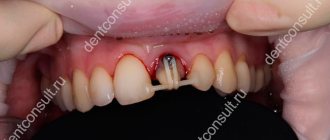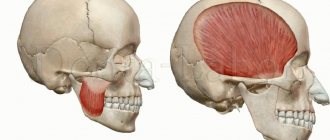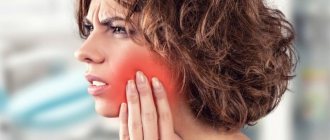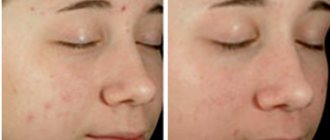Arsenyev Alexey Olegovich
Vascular surgeon, phlebologist, Ultrasound doctor
October 25, 2021
Of course, subcutaneous hemorrhage or bruising on the body can look unsightly and cause aesthetic discomfort. If this is an isolated situation, then, as a rule, there is nothing wrong with it. If the situation repeats: bruises occur in different places and, perhaps, complaints appear in other organs and systems (for example, pain in the heart, joints), then you should figure out why the vessels burst on the legs or body, as this may be a manifestation one of the more serious pathologies.
Symptoms of manifestation
Bruises on the face are difficult to ignore. It is characterized by knowledge of all standard symptoms, such as:
- Painful sensations in the facial area. And they are usually felt strongly because the ends of the facial nerves are among the most sensitive;
- Tissue swelling. This manifests itself as swelling of the skin, which may appear thickened upon palpation. The severity of edema depends not only on the severity of the injury, but also on the thickness of the skin and the internal structure of the tissues. Therefore, the area around the mouth and face is most susceptible to swelling;
- Bruises, bruises and hematomas. They arise as a result of damage to blood vessels and the accumulation of platelets in the damaged area. It’s worth saying right away that the deeper they are under the skin, the later the reaction will appear, but, unfortunately, the longer it will take. For this reason, many people start using ointments and gels for bruises even before visible signs appear;
- Feeling numb. This occurs in cases where the fibers of the facial nerve were directly affected during the injury. If nerve damage is very severe, there is a risk that reduced nerve activity may persist;
- Disruption of various areas of the face. Examples include: inability to see if the eye is swollen, difficulty breathing if the nose is injured, difficulty chewing food if the jaw is injured;
- Open bleeding. Observed when the skin is damaged at the site of the bruise and there is an open wound or deep scratch;
- Nausea, vomiting, loss of consciousness, convulsions. Such serious symptoms can occur if a bruise of the soft tissues of the face is accompanied by a traumatic brain injury and, as a consequence, impaired brain function.
Bruises and bruises are symptoms of contusion of the soft tissues of the face.
Of course, each of these symptoms may vary in severity in each individual case. Much depends on the individual characteristics of the body, such as the thickness of the skin or the elasticity of blood vessels. So, with one type of injury, one person may only have swelling, while another may have a severe hematoma.
Causes of bruises in the maxillofacial area
Most injuries occur unexpectedly and to varying degrees of severity.
Most often they are observed in the following cases:
- falling onto a hard surface;
- due to collision with objects;
- various impacts (road traffic accidents, domestic fights, contact sports).
Falls are the most common causes of injuries to the maxillofacial area
The severity of such injuries largely depends on the affected area, the type of object that affected the bone tissue and age-related changes in facial tissue.
First aid
First aid is recommended for injuries to the soft tissues of the face, regardless of the force of the blow. Here are three basic steps in this situation:
- Place something cold on the bruised area. This could be ice, snow, a compress soaked in cold water, or even a chilled metal spoon. Cold helps constrict blood vessels, reducing the risk of bruising under the skin. However, there are two things to keep in mind. Firstly, facial skin is quite thin and cannot be exposed to prolonged exposure. The optimal time is 15-20 minutes. The procedure can be repeated after 2 hours. Use material that protects the receptors from hypothermia. The second point is that the effectiveness of this method is available only in the first half hour after injury;
- If there are signs of skin trauma, be it wounds or abrasions, it is important to treat them with antiseptics. The most common of them are the well-known hydrogen peroxide, herbs, and a very weak solution of manganese solution. This must be done very carefully, since every touch to the wound can cause pain to the victim;
- Anesthesia. If the sensations are strong, you should turn to painkillers. Among them are Ketone, Ketorol, Ibuprofen. Before use, be sure to read the instructions.
First aid for bruised soft tissues of the face includes applying ice.
In most cases, the listed first aid measures for bruises are sufficient. However, if the injury is much more serious and the victim experiences heavy bleeding or convulsions, then the first step is to call an ambulance. When traveling, control bleeding with a tourniquet or position the person so that they do not risk swallowing their tongue.
It is important to remember that the method of providing first aid will affect the result of further treatment of facial bruises and the likelihood of developing complications.
Folk remedies
There are several proven, simple and at the same time effective ways to have the positive effects of alternative medicine. They are indispensable products for pregnant women, children, as well as people who have a severe allergic reaction to medications. You can make a choice based on personal preferences or doctor’s recommendations.
Treatment at home for bruises can be carried out using the following means:
- Table salt solution. Compresses are prepared from it, which are used for any complexity of bruises. To prepare, a tablespoon of salt is dissolved in 150 ml of boiled water. Then take a sterile bandage, soak it in the solution and apply it to the problem area. The compress is covered with a thick cloth on top. The gauze pad with salt can be left overnight.
- Grated potatoes. The tubers should be washed and cleaned first. Grate one tuber on a coarse grater, place in linen cloth and wrap several times. After applying the bruise, cover the top with a thick towel. Compressor exposure time is 30-40 minutes. For best results, make 3-4 applications in a row.
- Cabbage leaf. Before applying it, you should knead it a little or make cuts on it to let the juice out. The sheet is applied to the sore spot 2-4 times a day until it dries completely.
- Onion and garlic. The two ingredients are ground and mixed together. The resulting slurry is added with half a tablespoon of salt; it is recommended to wrap the mixture in gauze and place it in the area of the bruise.
- Beetroot and liquid honey. Finely grated root vegetables are mixed with a tablespoon of natural honey. The procedure is carried out 1-2 times a day for 2 hours.
- Laundry soap. This remedy helps reduce the pain response. The soap is grated and mixed with raw chicken yolk. I apply a compress every half hour up to 6-8 times a day. You can also rub a damp cloth with laundry soap and apply an application to the bruised area.
- Apple vinegar. This is one of the most effective remedies. To prepare the solution, you need to take 2 teaspoons of vinegar and dilute it in 1 liter. water. Soak a clean cloth in the solution and apply 3-4 times a day for half an hour.
Popular folk remedies for bruises
The video in this article shows how to properly apply a warm and cold compress for bruises.
Diagnostics
A bruise is easy to diagnose, but only doctors can determine its severity and possible complications. Therefore, if for any reason the injured area is bothering you, it is better not to waste time and seek professional help. The diagnosis can be made:
- inspection;
- palpation;
- Assessment of symptoms and complaints;
- In some cases, an ultrasound or x-ray examination may be required.
Diagnosis consists of determining not only the presence of a bruise, but also its severity. There are four degrees:
- First degree. This is the easiest and least dangerous option, involving a slight change in the structure of the subcutaneous tissue. There is no bleeding or hematoma, but blue skin discoloration is quite possible. For the first degree of injury, visiting a doctor is usually not required. It is quite possible to limit yourself to home remedies, which, with the right approach, will help eliminate symptoms in 5-7 days;
- Second step. In this case, significant damage to the subcutaneous and muscle tissue occurs. Severe swelling, pain and even hematoma may appear. It is better to treat such a bruise with medications together with physiotherapeutic procedures;
- Third degree. It damages not only muscle tissue, but also tendons. In some cases, the integrity of the skin may be compromised. Since there is a risk of developing an infectious process, examination by a doctor is mandatory.
- Fourth degree. This is the most severe and dangerous degree of injury. It is always accompanied by injuries not only to soft tissue, but also to bone tissue. In this case, there is a high risk of developing various types of complications. It is imperative to seek qualified medical help.
Accordingly, the type of treatment will directly depend on the degree and nature of the bruise.
Causes of intradermal hemorrhages
- Domestic injury
Living under time pressure, a person is constantly in a hurry to get somewhere and sometimes does not notice how in the course of his actions he receives some minor injuries or bruises. There is a direct cause-and-effect relationship in this: injury - damaged/burst vessels in the legs - bruise. There will be no injuries - there will be no hemorrhages.
- Phlebeurysm
With this disease, moderate venous hypertension is created in the superficial venous system due to valve incompetence and the formation of blood stagnation in the veins. Along with this, there is already an overstretched, swollen vein (varix - from the Latin swelling), the wall of which becomes thinner (analogy: the more we inflate a balloon, the more likely it is to burst), at some point it cannot stand it and bursts. Therefore, if a vein is swollen in the temple, leg or body, then you need to contact a vascular surgeon/phlebologist. And together with the doctor, plan treatment - from simple lifestyle modification to surgery to remove large veins.
- Non-physiological loads
A modern girl can walk or stand in high heels for 8–10 hours a day, which, in turn, leads to a significant weakening of the mechanisms of venous blood outflow and an increase in venous pressure, hypertension in the legs. This may contribute to the appearance of a bruise. The best solution in this situation is to give up heels or at least reduce the duration of wearing them, increase the volume of dynamic load, which also helps venous outflow.
- Taking hormonal medications containing female sex hormones (including oral contraceptives)
The reason for prescribing hormonal drugs may be banal contraception, treatment of gynecological, dermatological or other group of diseases. These drugs contain female sex hormones, which, in addition to regulating the cycle and the formation of secondary sexual characteristics in women, also affect the vascular system: they provoke bruises on the legs, the vessels become brittle, their elasticity decreases, and the diameter of the veins increases. The decision to discontinue, replace the drug and treat increased vascular fragility is made only after an in-person examination of the patient and review of the medical history. In this case, therapy is carried out by gynecologists, vascular surgeons/phlebologists.
- Condition after respiratory infections
Most viruses (influenza, parainfluenza, coronavirus infection, ARVI) are tropic to vascular structures, and after a person has had one of them, bruises may appear on the body that were not there before. In this situation, the body needs to be given time to recover; you can also include in your diet foods rich in vitamin C (citrus fruits, kiwi, rose hips, sea buckthorn, black currants, parsley, broccoli, sweet red peppers, sauerkraut, etc.), vitamin P ( citrus fruits, buckwheat, black currants, rose hips, raspberries, tomatoes, beets, red bell peppers, asparagus, plums, etc.). It is possible to take synthetic analogues of these drugs, but before doing so, you must see a doctor.
- Vasculitis
A group of diseases that is accompanied by inflammation of the vascular wall, and sometimes by its increased permeability and fragility.
Vasculitis is divided into several types:
- Primary is an independent process in the vascular system, and not a consequence of the pathology of other organs. The group of primary vasculitis, accompanied by the appearance of bruises, includes: Wegener's granulomatosis, Churg-Strauss syndrome, microscopic polyangiitis, Henoch-Schönlein purpura, hypersensitivity vasculitis, cryoglobulinemic vasculitis, Behçet's disease, vasculitis in rheumatic diseases (systemic lupus erythematosus, rheumatoid arthritis, Sjögren), etc. In such cases, etiotropic therapy of the pathology, that is, treatment of the underlying cause, is carried out by a rheumatologist, and vascular surgeons/phlebologists, cardiologists, and dermatologists help treat the consequences of the disease.
- Secondary - there is another disease (oncological or infectious origin), against the background of which hemorrhages appear on the skin. One example is vasculitis against the background of exacerbation of viral hepatitis. This also includes the previously mentioned respiratory infections. With effective treatment of the underlying disease, bruising on the body disappears.
Treatment
Treatment methods for bruises can be divided into two large groups: traditional in the form of drugs and treatment methods, and non-traditional in the form of traditional medicine. Ideally, you can combine techniques from both groups. This solution will help you get rid of bruises in less time.
Medication
If the situation does not require hospitalization, the bruise is treated using standard methods. Namely:
- Preparations for external use: gels, ointments, creams;
- Physiotherapeutic procedures. These include electrophoresis, heating, laser therapy. All these procedures are aimed at eliminating subcutaneous clots and stimulating skin regeneration.
Creams, ointments, and other treatments for bruises are widely available.
In every pharmacy you can find a huge selection of such products. But when choosing, it is important to pay attention to the composition, influence and age restrictions. Not all products are suitable for children.
With regular and correct use of the ointment, you can get rid of bruises and swelling within a few days. And if you supplement your treatment with physical therapy, you can expect results even faster.
Traditional methods
Bruises and bruises can also be treated with traditional medicine. The only rule is that you can start using them a few days after the injury.
Among the folk recipes for bruises and bruises on the face it is worth mentioning:
- Cabbage leaf or raw potato. They should be applied to the damaged area. Thanks to this, swelling quickly decreases;
- Honey. Has a good laxative and anti-inflammatory effect. You can even not limit yourself to the area of the bruise, but apply honey all over your face, creating the appearance of a mask;
- Camphor oil. To obtain the effect, it must be applied with light rubbing movements;
- Compresses. It is best to cook them with onions or salt;
- Alcohol-based compresses. In this case, the rosemary plant can be the basis. Has a warming and antiseptic effect;
- Arnica decoction. This measure is applied not externally, but internally. It not only strengthens the immune system, but also stimulates regenerative processes.
Applications with honey are a folk method for treating bruises of the soft tissues of the face.
And, of course, one should not underestimate the influence of standard massage measures in the form of light stroking and rubbing.
Diagnostic measures
If minor injuries to the maxillofacial area occur, they do not require contact with a dentist or surgeon, or urgent hospitalization. If there is severe and prolonged pain, the area of damage should be examined by a specialist.
The following are used as diagnostics:
- taking anamnesis;
- general examination by a surgeon, orthopedic dentist, traumatologist;
- special examination by an otolaryngologist, neurologist and other specialized specialists as necessary;
- X-ray examination of the maxillofacial area;
- CT scan;
- analysis of blood, urine, saliva.
Based on the data obtained, a general picture of the victim’s health is formed and a specific treatment is recommended.
The main therapeutic direction will be the following:
- taking painkillers;
- applying a pressure bandage;
- ensuring maximum peace for the victim;
- prescription of physiotherapeutic procedures;
- local and general anesthesia;
- elimination of hematoma and infiltrate.
Consequences
Complications with bruises are quite possible. It all depends on the nature of the injury and which area of the face was damaged. Possible consequences include:
- Nerve damage. completion. This is quite dangerous, since it is not always possible to fully restore their functionality. This means that the affected part of the face may stop moving;
- Deterioration of vision. If the area around the eyes is bruised, there is also the possibility of damage to the nerve responsible for visual functions. Again, the outcome depends on the nature of the injuries. Both partial and complete loss of vision is possible, which is much less common;
- suppuration at the site of the bruise in the form of an abscess;
- bleeding that, if not treated immediately, may lead to fainting or shock;
- Cyst formation in the presence of hematomas.
In case of serious injuries, the bruise may be accompanied by a concussion, deformation of the bones of the nose or jaw. As a result, a person may later suffer from conditions such as sinusitis or sinusitis.
Damage to the lower jaw
This injury is the most common. It occurs in both children, adults and the elderly. The important point is to identify the type of damage as soon as possible and provide first aid. The further prognosis and duration of treatment will depend on this.
A mandibular contusion is a soft tissue injury in the lower parts of the face. As a result, an internal hematoma is formed due to the rupture of small blood vessels.
In the event of a bruise, the bone tissue remains intact and the teeth and gums are not injured. Usually occurs as a result of impact on the maxillofacial area with a blunt object.
Bruise of the jaw after a blow to the lower parts of the face on the left side
The severity of the injury is largely influenced by the moment of impact. Severe consequences are observed with highly tense muscles. In this case, they rupture, forming an extensive hematoma with a pronounced pain reaction.
Main symptoms
Any disease has its own fundamental signs. Symptoms of a bruise of the lower jaw are usually quite striking. The main sign is sharp pain, abrasions, damage to the cheek or lip.
If the blow falls on the area of the dental arch, then gaping wounds form on the soft tissues on the side of the oral cavity. The lower lip looks swollen, sagging and hyperemic.
To make a correct diagnosis, differential diagnosis is necessary. It is important to exclude fractures of the bone areas of the jaw, eye socket and nose.
After a strong blow, the victim should not be left unattended. It is imperative to monitor his general condition. Together with complaints and external examination, a preliminary diagnosis can be established.
In addition to local signs, general manifestations should also be taken into account:
- damage in the form of scratches and hyperemia in the jaw area;
- swelling in the lower part of the face;
- the presence or absence of hematoma of varying volume;
- malaise and swollen lymph nodes;
- sharp or constant pain even at rest;
- impairment in mouth opening, eating and speaking;
- increased pain response from touching the damaged area, as well as movement of the jaw to the left or right side.
Attention!!! The main differential diagnostic sign of a bruise from a fracture is that the jaw bones do not change their anatomical structure. In addition, the line of bone integrity violation can be determined by palpation.
If the injury is severe, the victim must in any case be taken to a doctor for examination to clarify the condition. It is important to carry out rapid transportation with preliminary first aid.
Prevention
Almost all of us have had bruises on the soft tissues of our faces in our lives. Unfortunately, this cannot be completely prevented. However, in order to at least minimize the risk, it is necessary to take basic precautions and safety measures. When it comes to children, it is important to teach them from an early age how to avoid traumatic situations.
If facial bruises do occur, do not leave it unattended and take appropriate measures. You can do this yourself or seek medical help.
Damage to the upper jaw
The nature of injury in this area is more complex. Its danger lies in the fact that serious complications may occur. It is quite easy to distinguish a bruise of the upper jaw from the lower one.
This is determined by the location of the pain and the consequences of trauma. However, it should be taken into account that unpleasant sensations can radiate to the lower part of the face. But the main difference here will be the absence of impaired mobility of the lower jaw.
The symptoms of a bruise of the upper bone tissues are very similar to the previous problem. There is an inflammatory process and pain, swelling, and sometimes enlargement of regional lymph nodes. Even if there are no obvious signs of bruises, you need to go to the clinic.
The photo shows fractures of the upper jaw with severe bruises
The doctor must first rule out a fracture. In the upper jaw, such injuries are dangerous for brain damage.
For example, a Le Fort 3 fracture is a separation of the bones of the skull and face. Without professional medical care, death can occur in this case.









